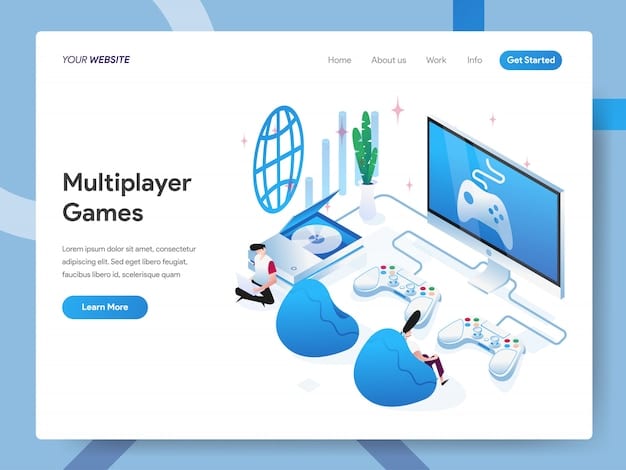PC Game Review Trends: Navigating Criticisms in 2025

Navigating the evolving landscape of PC game reviews in 2025 reveals dominant criticisms revolving around unfulfilled promises, predatory monetization, technical instability, and a perceived lack of innovation, shaping both consumer expectations and developer practices.
The world of PC gaming is a dynamic and ever-evolving landscape, where innovation meets passionate communities. For both developers and players, understanding the current state of critical reception is paramount. This article delves into the most prevalent and impactful PC Game Review Trends: Analyzing the Most Common Criticisms in 2025, offering an in-depth look at what shapes public perception and drives the conversation around new releases.
The Shifting Sands of Player Expectations
The expectations of PC gamers in 2025 have reached an unprecedented level, largely shaped by years of technological advancements and a growing awareness of development cycles. What was once considered innovative can quickly become standard, and what was acceptable performance a decade ago is now often deemed subpar. This heightened scrutiny forms the bedrock of many contemporary criticisms.
Players are not just looking for a new game; they are seeking an experience that justifies their investment of time and money. This includes not only the initial purchase price but also the significant time commitment involved in learning, playing, and mastering a complex title. As such, the bar for quality and engagement has been progressively raised, forcing developers and publishers to reconsider their strategies from concept to post-launch support. The market is saturated with options, meaning competition for player attention is fierce, and only those games that truly resonate tend to rise above the noise.
Unrealistic Hype and Misleading Marketing
One of the most enduring criticisms in PC game reviews centers on the disconnect between pre-release marketing and the final product. Developers often showcase games with meticulously crafted trailers and polished demos that may not accurately represent the in-game experience. This can lead to significant disappointment when players finally get their hands on the release version.
* Graphical Downgrades: Instances where the visual fidelity seen in trailers is significantly higher than that of the actual game.
* Gameplay Differences: Divergences in mechanics, scope, or features from what was initially promised or implied.
* Feature Omission: Important elements or modes advertised prior to launch that are either absent or heavily scaled back in the final game.
The pressure to generate hype is immense in the competitive gaming industry, yet this pressure can inadvertently create a cycle of inflated expectations followed by widespread dissatisfaction. Building anticipation responsibly, with clear transparency about game features and development progress, becomes crucial for maintaining player trust. When trust is broken, it can take years for a studio to fully recover its reputation, especially in the era of viral social media criticisms.
Many players now approach pre-orders with extreme caution, often waiting for day-one reviews and community feedback before committing their funds. This trend is a direct response to past experiences where early access or pre-order bonuses did not compensate for a rushed or unfinished product. The industry is slowly adapting, with some developers opting for more modest marketing campaigns and relying on organic word-of-mouth once the game is released and proven to be of high quality.
Beyond the initial marketing, ongoing communication throughout a game’s lifecycle is also under scrutiny. Publishers that are transparent about roadmaps, challenges, and upcoming updates tend to foster stronger, more forgiving communities. Conversely, silence or evasiveness when problems arise often exacerbates negative sentiment, turning minor issues into major grievances that fuel a spiral of criticism.
Monetization Gone Awry: The Microtransaction Maelstrom
The past decade has seen a dramatic shift in how games are monetized, particularly in the PC space. While traditional upfront purchases remain dominant, the integration of microtransactions, season passes, and various forms of in-game purchases has become a pervasive element. For many players, these monetization strategies have become a significant source of contention.
Predatory Practices and Pay-to-Win Mechanics
The fundamental criticism here revolves around microtransactions that are perceived as exploitative rather than additive. When in-game purchases offer a distinct competitive advantage, or when progression feels intentionally slowed to push players towards spending, reviews often turn sharply negative.
* Slam-dunk: The game feels like a money grab, with essential content or power locked behind paywalls.
* Arbitrary Grind: Progression systems designed to be excessively long or tedious without spending real money.
* Loot Boxes/Gacha Mechanics: Random chance elements where players spend money for an unknown reward, often criticized as akin to gambling.
The balance between profitability and player satisfaction is a delicate one. When monetization overshadows genuine gameplay experience, it inevitably leads to backlash. Players are generally more accepting of cosmetic microtransactions or expansions that add substantial new content, but express strong disapproval for anything that impacts core gameplay fairness or exploits psychological vulnerabilities. Ethical monetization is increasingly a cornerstone of positive game reviews.
The rise of “games as a service” models has amplified these discussions. While the promise of continuous updates and fresh content is appealing, it often comes with the caveat of ongoing monetization. If the value proposition isn’t clear, and if the continuous revenue streams appear to dictate design choices rather than enhance player experience, reviewers are quick to call it out. The industry is currently experimenting with various hybrid models, but those that prioritize short-term revenue over long-term player satisfaction invariably face public scorn.
This critique extends beyond new releases to established titles that introduce new monetization models post-launch. Sudden changes that limit player access to content or slow progression without additional spending are met with fierce resistance. Players feel a sense of ownership over a game they have invested in, and changes perceived as eroding that value often result in a significant drop in review scores and community engagement.
Technical Debt and Performance Woes
In the realm of PC gaming, performance and stability are paramount. Unlike console ecosystems, the vast array of hardware configurations on PC means that optimization is a complex and continuous challenge. Yet, a recurring and virulent criticism in 2025 is the release of games suffering from significant technical issues.
Bugs, Glitches, and Crashes Galore
The internet is rife with examples of games launching in a state riddled with bugs, from minor visual glitches to game-breaking crashes. Reviewers often highlight these issues, as they directly impede the player’s ability to enjoy the game as intended.
* Unplayable Framerates: Poor optimization leading to consistently low or unstable frame rates, even on high-end hardware.
* Frequent Crashes: Games that crash to desktop regularly, causing lost progress and frustration.
* Game-Breaking Bugs: Glitches that prevent players from completing quests, progressing through the story, or utilizing core mechanics.
The “day one patch” has become a common, yet often insufficient, solution. Players expect a game to be stable and functional at launch, not weeks or months later. This trend of releasing unfinished products has eroded consumer confidence, leading to a “wait and see” approach before purchase. The sheer amount of data available online, from independent benchmarks to player-recorded gameplay, means that technical shortcomings are quickly exposed and widely disseminated.
Maintaining a rigorous quality assurance (QA) process is more critical than ever. However, the economic pressures of development and release schedules often lead to these processes being cut short. The result is a cycle of rushed launches, negative reviews, and a scramble to patch problems post-release. This approach not only frustrates players but can also damage the long-term reputation of a studio, making future game launches a harder sell.
Furthermore, connectivity issues, prevalent in online multiplayer games, are also a frequent target of criticism. Server instability, high latency, and frequent disconnections can completely derail the experience, regardless of how good the core gameplay might be. Players expect robust online infrastructure to support their competitive or cooperative ventures, and anything less is often met with harsh judgment.

Innovation Stagnation: The “More of the Same” Syndrome
While players appreciate refined mechanics, there’s a growing fatigue regarding titles that feel like iterative updates rather than genuine advancements. Critical reviews in 2025 frequently lament the lack of bold new ideas, pointing towards a perceived reluctance by developers to step outside established formulas. This focus on the familiar can sometimes lead to games that are technically competent but creatively uninspired.
Lack of Originality and Repetitive Gameplay Loops
Many reviews express disappointment when a new game in a popular genre fails to bring anything new to the table, instead recycling mechanics and narratives from its predecessors or highly successful competitors. This can lead to a sense of déjà vu, dulling the excitement of discovery.
* Formulaic Design: Games adhering too closely to established genre conventions without meaningful deviation.
* Recycled Assets/Mechanics: A noticeable reuse of design elements or gameplay loops from previous titles or other popular games.
* Predictable Narratives: Storylines that follow well-worn tropes without offering fresh perspectives or engaging twists.
The sheer volume of games released annually means that standing out requires more than just polish; it demands a unique selling proposition. Developers who bravely experiment with new mechanics, themes, or narrative structures often receive critical acclaim, even if their games are not perfect. Conversely, those who play it safe are typically met with lukewarm reception, as reviewers and players alike seek experiences that genuinely surprise and engage.
This criticism is particularly acute for long-running franchises. While fans often crave familiarity, they also expect growth and evolution within the series. When a new installment feels like a minor update rather than a significant leap forward, it can alienate the very fanbase it aims to please. Balancing tradition with innovation is a constant tightrope walk for established IPs. The challenge lies in respecting the core identity of a franchise while simultaneously pushing its boundaries in meaningful ways that resonate with both veteran players and newcomers.
Furthermore, the pressure to produce hits often leads to a risk-averse environment where “proven” formulas are preferred over speculative ventures. This can stifle creativity across the industry as a whole. Reviewers are keenly aware of this trend and often use their platforms to advocate for bolder artistic choices, rewarding games that dare to be different, even if they don’t achieve mainstream success.
Post-Launch Support and Content Droughts
The journey for a modern PC game rarely ends at launch. The “games as a service” model, coupled with developer promises of ongoing content, has made post-launch support a critical aspect of review analysis. When these promises aren’t met, or when content updates are subpar, it becomes a major point of criticism.
Broken Roadmaps and Neglected Communities
Players invest not only in the initial game but often in the developer’s commitment to its future. When roadmaps for new content, bug fixes, or quality-of-life improvements are abandoned or significantly delayed, it leads to frustration and negative reviews.
* Unfulfilled Promises: Content or features explicitly promised in post-launch roadmaps that never materialize.
* Slow Patching: Glaring bugs or balance issues that remain unaddressed for prolonged periods.
* Communication Blackouts: Developers going silent on community concerns and development updates.
The long-term health of a game, especially one with a strong multiplayer component, depends heavily on consistent engagement from its developers. Regular updates, transparent communication, and community feedback integration are vital for sustaining player interest and positive reviews. A game that launches with potential but then stagnates due to lack of support often sees its initial positive reception erode over time.
This criticism ties into the broader issue of trust between developers and players. When a developer fails to support a game adequately after launch, it impacts their credibility for future projects. Players remember when commitments are not honored, and this memory often manifests in skepticism during future marketing campaigns. A strong track record of consistent and meaningful post-launch support, conversely, builds goodwill and a loyal player base.
The quality of post-launch content is also under scrutiny. Players are quick to criticize new content that feels rushed, uninspired, or that merely recycles existing assets. “Content droughts,” where a game goes for extended periods without meaningful updates, are also a common source of complaint, causing players to drift away to new releases that offer a more consistent stream of fresh experiences.
Accessibility and Inclusivity: A Growing Imperative
While not always the primary focus of traditional gameplay reviews, the discourse around accessibility features and inclusivity in PC games has gained significant traction by 2025. Criticisms often arise when games fail to meet modern standards for accommodating diverse player needs or when their representations are narrow or stereotypical.
Limited Accessibility Options and Representation Gaps
Reviews increasingly highlight when games lack fundamental accessibility features that enable a wider audience to participate. Similarly, the absence of diverse representation in characters and narratives can draw criticism for reinforcing outdated norms.
* Lack of Essential Accessibility: Absence of customizable controls, colorblind modes, subtitle options, or difficulty scaling.
* Underrepresentation: Games featuring a limited range of character types, ethnicities, genders, or abilities.
* Stereotypical Portrayals: Characters or narratives that rely on harmful stereotypes instead of nuanced depictions.
Accessibility features are no longer just a bonus; they are increasingly seen as a fundamental aspect of good game design. Developers who prioritize options that cater to players with various impairments often receive praise for their thoughtful approach. Conversely, those who neglect these aspects are seen as exclusionary, limiting their potential audience.
Beyond technical accessibility, the social and cultural aspects of inclusivity are also being scrutinized. Modern players, particularly younger demographics, expect games to reflect the diverse world they live in. This includes nuanced character development that goes beyond tokenism and narratives that explore varied perspectives. Reviews can be influenced by whether a game successfully creates an environment where a broad range of players feel seen, respected, and represented. Developers who thoughtfully integrate these elements are often rewarded with positive community reception and broader appeal.
The critical lens on representation also extends to themes and historical contexts. Games that touch on sensitive subjects or historical events are expected to do so with research, respect, and nuance. Superficial or exploitative portrayals often lead to strong negative reactions and can overshadow other positive aspects of a game. The gaming audience continues to mature, and with that comes a demand for more sophisticated and responsible content creation.

The Review Landscape Itself: Bias and Integrity Concerns
An metacriticism that has permeated the PC game review sphere in 2025 is the critique of the review process itself. Players and developers alike are often wary of perceived biases, conflicts of interest, and the sheer volume of reviews, making it difficult to discern truly objective assessments.
Influence of Marketing Budgets and Early Access
A frequent complaint is that large marketing budgets and exclusive early access opportunities for reviewers can subtly influence coverage, leading to less critical reviews for major titles. The independence of review outlets is constantly under scrutiny.
* Embargo Restrictions: Reviewers sometimes feel pressured by strict embargo clauses that limit their ability to fully test or openly criticize a game.
* Advertising Influence: Concerns that outlets reliant on advertising revenue from publishers might pull punches in their reviews.
* Early Access Advantages: Reviewers receiving special builds or access, potentially playing a more polished version than the general public’s launch build.
The challenge for reviewers is to maintain absolute independence while also gaining timely access to games. Transparency about review policies, potential conflicts of interest, and the conditions under which reviews are conducted is paramount for building trust with readers. The rise of independent content creators and streamers has partially mitigated this, offering alternative perspectives that are often perceived as less beholden to traditional industry relationships.
Furthermore, the sheer volume of review content—from professional outlets to user scores—can be overwhelming. Criticisms arise when it becomes difficult to distinguish between genuine, well-reasoned analyses and superficial or emotionally charged opinions. Aggregator sites attempt to provide a consolidated view, but even they face challenges in weighting different types of feedback appropriately. The future of review credibility hinges on clear methodologies and a commitment to objectivity that transcends commercial pressures.
The phenomenon of “review bombing,” where a game receives a barrage of negative user reviews for reasons unrelated to its gameplay quality (e.g., political stances of the developer, platform exclusivity), also complicates the landscape. This makes it harder for consumers to rely solely on aggregate user scores, pushing them towards more detailed, trusted critical analyses. Ultimately, the health of the review ecosystem depends on an ongoing commitment to ethical practices from all parties involved.
| Key Criticism | Brief Description |
|---|---|
| 📢 Unfulfilled Promises | Marketing hype often misrepresents the final product, leading to player disillusionment. |
| 💰 Predatory Monetization | Aggressive in-game purchases and pay-to-win mechanics undermine fair gameplay. |
| 🐛 Technical Instability | Games often launch with numerous bugs, crashes, and poor optimization, frustrating players. |
| ♻️ Innovation Stagnation | Many titles are criticized for lacking originality and offering repetitive gameplay loops. |
Frequently Asked Questions About PC Game Review Trends in 2025
▼
In 2025, major factors include unfulfilled marketing promises, predatory monetization practices like pay-to-win systems, persistent technical issues at launch, and a perceived lack of innovation. These issues often lead to player disappointment and harsh critical reception, impacting a game’s long-term success and reputation.
▼
“Hypesmanship” often refers to exaggerated marketing that sets unrealistically high player expectations. When the final game fails to live up to the spectacular trailers or promises, it results in significant backlash, commonly manifesting as negative reviews and a loss of trust even if the game is otherwise decent.
▼
Yes, microtransactions remain a significant concern, especially when they disrupt core gameplay or feel exploitative. Reviews frequently criticize practices like “pay-to-win” mechanics or loot boxes, whereas cosmetic-only purchases are generally more accepted. The balance between profitability and player value is constantly being scrutinized.
▼
With many games adopting a “games as a service” model, players expect continuous updates, bug fixes, and new content. Poor post-launch support, unfulfilled roadmaps, or communication droughts lead to negative reviews, as players feel their investment in the game’s longevity is not respected by developers.
▼
Accessibility features and inclusive representation are becoming increasingly important. Reviews now often highlight the lack of options for diverse player needs (e.g., colorblind modes, customizable controls) or criticize stereotypical portrayals, reflecting a growing demand for games that cater to a broader and more diverse audience.
Conclusion
The landscape of PC game reviews in 2025 is a complex tapestry woven from technological expectations, commercial pressures, and evolving player demands. The dominant criticisms — ranging from misleading marketing and predatory monetization to technical instability and a lack of creative originality — underscore a persistent tension between industry practices and consumer desires. As players increasingly prioritize transparency, ethical design, and sustained value, developers and publishers are continually challenged to adapt. Understanding these critical trends is not merely about identifying flaws, but about recognizing the evolving standards that drive the future of gaming, pushing the industry towards greater accountability, innovation, and ultimately, more fulfilling experiences for everyone.





